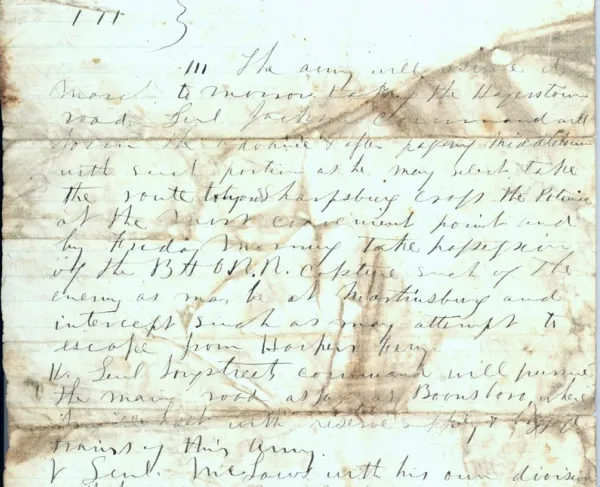
In our Fall 2012 issue of Hallowed Ground, four historians made a case for why their respective battle was the pivotal moment of the 1862 Maryland Campaign. Dennis Frye, the chief historian at Harpers Ferry National Park made the case for the Battle of Harpers Ferry.
Robert E. Lee was on his way to Pennsylvania, until Harpers Ferry halted him – and changed the destiny of the Confederacy.
September opened with momentum and aspiration for the South. “I propose to enter Pennsylvania,” Lee informed Confederate president Jefferson Davis on September 4, 1862. Certain of success, Davis immediately issued a proclamation declaring Thursday, September 18, as Confederate Thanksgiving Day. “As a people, we should bow down in adoring thankfulness to that gracious God who has been our bulwark and defense, and offer unto Him the tribute of thanksgiving and praise.”
One week later, on September 11, Lee arrived in Hagerstown, Md. — less than six miles from the Mason-Dixon Line. Every indication pointed to the Confederate army celebrating its Thanksgiving Day in William Penn’s colony.
Philadelphia quaked. Ten days of good marching would bring the Confederates upon America’s second largest city. No one expected the tentacles of civil war to grasp the birthplace of American independence. “In such an emergency what is our condition?” gasped the Philadelphia Inquirer. Not good. No fortifications. No generals. No gunboats. No plan of defense. No army in sight. When the Rebel press announced intentions to dictate terms of peace in Independence Square, the Inquirer worried. “We now know the worst .... How is all of this to be remedied?”
Washington provided no good answers. It did, however, make a decision that serendipitously confounded Lee’s sojourn into Pennsylvania. Federal authorities sent the U. S. garrison commander at Harpers Ferry emphatic instructions: “You will not abandon Harpers Ferry without defending it to the last extremity.”
Harpers Ferry thus presented General Lee with a problem. The 14,000 bluecoats holding the town and the northern Shenandoah Valley posed a threat to Lee’s supply line from Virginia into Maryland — and eventually, Pennsylvania. Lee expected the Federals to abandon Harpers Ferry, as his invasion route to Frederick had effectively isolated the position, severing all communication and relief from Washington.
But the Federals did not budge, compelling Lee to move against Harpers Ferry. The Confederate chieftain halted his drive toward Pennsylvania to eradicate the Harpers Ferry thorn in his rear. Lee expected the halt to be temporary, but Harpers Ferry ultimately proved fatal to the Rebel invasion.
Lee determined to extinguish the Harpers Ferry problem with force. He ordered two-thirds of his army to that target, directing three columns to seize the three mountains surrounding the town. Lee selected Stonewall Jackson to lead this operation, with detailed instructions scribbled into Special Orders 191. Once Jackson succeeded, Lee would reunite his army and continue his march into Yankee territory with his supply line unimpeded. He expected Jackson to have the mission finished or in its final stages in three days, as little resistance was expected from the Harpers Ferry garrison. The Federals were inexperienced raw recruits, many with only three weeks of military service — easy prey for Jackson’s veterans. Lee also anticipated no problem from the massive Federal army near Washington. Jackson would complete the assignment long before any Union rescuers could arrive.
Fate . . . and late . . . destroyed Lee’s plans.
Fate occurred when a copy of Special Orders 191 somehow became lost, ending up in the hands of Union commander George B. McClellan. “I have all the plans of the rebels, and will catch them in their own trap,” proclaimed a confident McClellan, setting into motion a Union rescue mission to Harpers Ferry, via the gaps of South Mountain.
“Late” transpired when Stonewall Jackson failed to complete the Harpers Ferry operation in the prescribed three days. Jackson’s three columns, in fact, did not arrive near the Ferry until the fourth day. Two more days were lost when the Federals decided to stand rather than surrender. Harpers Ferry hung a noose around Lee’s invasion.
The situation became so desperate for Lee that he abandoned his perch at Hagerstown, where he was gazing into Pennsylvania, and came rushing back to block the vulnerable gaps of South Mountain and give Jackson more time for success at Harpers Ferry. Receiving no positive word from Stonewall, Lee made one of his most depressing decisions on Sunday night, September 14. “The day has gone against us. This army will go by way of Sharpsburg and (emphasis added) cross the river.”
Lee cancelled the invasion — a direct result of his failure at Harpers Ferry. No Confederate Thanksgiving Day in Pennsylvania. No negotiation of peace in Independence Square. No defeat of the enemy army on Northern soil. The stubborn stand of Harpers Ferry had wrecked the Confederate invasion.
Suddenly, however, Lee’s despondency turned to hope. While resting his beleaguered army near the Antietam Creek during his retreat back to Virginia, Lee received a courier message from Jackson. “Through God’s blessing, I believe Harpers Ferry and its garrison will surrender on the morrow” (September 15). When word arrived that Jackson had succeeded — achieving a complete tactical victory and the surrender of 12,000 Yankees —Lee decided to wait in Maryland for Jackson and two-thirds of his army to rejoin him near Sharpsburg.
The Battle of Antietam never would have occurred without Jackson’s ultimate victory at Harpers Ferry. Lee had decided to leave Maryland. He had terminated the invasion. He reversed this decision only with the good news that Harpers Ferry finally had collapsed, offering him the opportunity to reunite his army.
Unfortunately for General Lee, McClellan attacked him before all of his Harpers Ferry detachments arrived at Antietam. Fortunately for Marse Robert, troops arriving from Harpers Ferry saved him from collapse in the West Woods fight. Even more fortuitous for the Confederacy, Maj. Gen. A. P. Hill’s division rushed from Harpers Ferry, arriving just in time to save Lee’s army from demolition after the loss of the crossing now known as Burnside’s Bridge.
Harpers Ferry was Lee’s umbilical cord to Antietam, and the troops arriving from there ensured the continued existence of Lee’s Confederate army. Thus, for both its stubborn stand and in its surrender, Harpers Ferry constitutes the pivotal moment of the Maryland Campaign.
Learn More About the Pivotal Moments of the Maryland Campaign: The Case for Antietam | The Case for South Mountain | The Case for Shepherdstown
Related Battles
12,636
286






